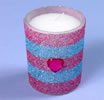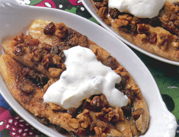They can help, but a truly "clean" kitchen--that is, one that ensures safe food--relies on more than just looks: It also depends on safe food practices.
In the home, food safety concerns revolve around three main functions: food storage, food handling, and cooking. To see how well you're doing in each, take this quiz, and then read on to learn how you can make the meals and snacks from your kitchen the safest possible.
Quiz
Choose the answer that best describes the practice in your household, whether or not you are the primary food handler.
1.
The temperature
of the
refrigerator in
my home is:
a. 50 degrees
Fahrenheit (10
degrees Celsius)
b. 40 F (5 C)
c. I don't know;
I've never
measured it.
2.
The last time we
had leftover
cooked stew or
other food with
meat, chicken or
fish, the food
was:
a. cooled to
room
temperature,
then put in the
refrigerator
b. put in the
refrigerator
immediately
after the food
was served
c. left at room
temperature
overnight or
longer
3.
The last time
the kitchen sink
drain, disposal
and connecting
pipe in my home
were sanitized
was:
a. last night
b. several weeks
ago
c. can't
remember
4. If
a cutting board
is used in my
home to cut raw
meat, poultry or
fish and it is
going to be used
to chop another
food, the board
is:
a. reused as is
b. wiped with a
damp cloth
c. washed with
soap and hot
water
d. washed with
soap and hot
water and then
sanitized
5.
The last time we
had hamburgers
in my home, I
ate mine:
a. rare (140 F)
b. medium (160
F)
c. well-done
(170 F)
6.
The last time
there was cookie
dough in my
home, the dough
was:
a. made with raw
eggs, and I
sampled some of
it
b. made with raw
eggs and
refrigerated,
then I sampled
some of it
c. store-bought,
and I sampled
some of it
d. not sampled
until baked
7. I
clean my kitchen
counters and
other surfaces
that come in
contact with
food with:
a. water
b. hot water and
soap
c. hot water and
soap, then
bleach solution
d. hot water and
soap, then
commercial
sanitizing agent
8.
When dishes are
washed in my
home, they are:
a. washed and
dried in an
automatic
dishwasher
b. left to soak
in the sink for
several hours
and then washed
with soap in the
same water
c. washed right
away with hot
water and soap
in the sink and
then air-dried
d. washed right
away with hot
water and soap
in the sink and
immediately
towel-dried
9.
The last time I
handled raw
meat, poultry or
fish, I cleaned
my hands
afterwards by:
a. wiping them
on a towel
b. rinsing them
under hot, cold
or warm tap
water
c. washing with
soap and warm
water
10.
Meat, poultry
and fish
products are
defrosted in my
home by:
a. setting them
on the counter
b. placing them
in the
refrigerator
c. microwaving
11.
When I buy fresh
seafood, I:
a. buy only fish
that's
refrigerated or
well iced
b. take it home
immediately and
put it in the
refrigerator
c. sometimes buy
it straight out
of a local
fisher's creel
12. I
realize people,
including
myself, should
be especially
careful about
not eating raw
seafood, if they
have:
a. diabetes
b. HIV infection
c. cancer
d. liver disease
Answers
1. Refrigerators should stay at 40 F (5 C) or less, so if you chose answer B, give yourself two points. If you didn't, you're not alone. According to Robert Buchanan, Ph.D., senior science adviser and director of science in the Food and Drug Administration's Center for Food Safety and Applied Nutrition, many people overlook the importance of maintaining an appropriate refrigerator temperature.
"According to surveys, in many households, the refrigerator temperature is above 50 degrees (10 C)," he said.
His advice: Measure the temperature with a thermometer and, if needed, adjust the refrigerator's temperature control dial.
A temperature of 40 F (5 C) or less is important because it slows the growth of most bacteria. The temperature won't kill the bacteria, but it will keep them from multiplying, and the fewer there are, the less likely you are to get sick.
Freezing at zero F (minus 18 C) or less stops bacterial growth (although it won't kill bacteria already present).
2. Answer B is the best practice; give yourself two points if you picked it.
Hot foods should be refrigerated as soon as possible within two hours after cooking. But don't keep the food if it's been standing out for more than two hours. Don't taste test it, either. Even a small amount of contaminated food can cause illness.
Date leftovers so they can be used within a safe time. Generally, they remain safe when refrigerated for three to five days. If in doubt, throw it out, says FDA microbiologist Kelly Bunning, Ph.D., associate senior science adviser in CFSAN: "It's not worth a foodborne illness for the small amount of food usually involved."
3. If answer A best describes your household's practice, give yourself two points. Give yourself one point if you chose B.
According to John Guzewich, CFSAN's director of emergency coordination and response, the kitchen sink drain, disposal and connecting pipe are often overlooked, but they should be sanitized periodically by pouring down the sink a solution of 1 teaspoon (5 milliliters) of chlorine bleach in 1 quart (about 1 liter) of water or a solution of commercial kitchen cleaning agent made according to product directions. Food particles get trapped in the drain and disposal and, along with the moistness, create an ideal environment for bacterial growth.
4. If answer D best describes your household's practice, give yourself two points.
If you picked A, you're violating an important food safety rule: Never allow raw meat, poultry and fish to come in contact with other foods. Answer B isn't good, either. Improper washing, such as with a damp cloth, will not remove bacteria. And washing only with soap and water may not do the job, either.
To prevent cross-contamination from a cutting board, the FDA advises consumers to follow these practices:
- Use smooth cutting boards made of hard maple or a non-porous material such as plastic and free of cracks and crevices. These kinds of boards can be cleaned easily. Avoid boards made of soft, porous materials.
- Wash cutting boards with hot water, soap, and a scrub brush to remove food particles. Then sanitize the boards by putting them through the automatic dishwasher or rinsing them in a solution of 1 teaspoon (5 milliliters) of chlorine bleach in 1 quart (about 1 liter) of water.
- Always wash and sanitize cutting boards after using them for raw foods and before using them for ready-to-eat foods. Consider using one cutting board only for foods that will be cooked, such as raw fish, and another only for ready-to-eat foods, such as bread, fresh fruit, and cooked fish. Disposable cutting boards are a newer option, and can be found in grocery and discount chain stores.
5. Give yourself two points if you picked answer B or C.
Ground beef must be cooked to an internal temperature of 160 degrees Fahrenheit (71 degrees Celsius). Using a digital or dial food thermometer is crucial, the U.S. Department of Agriculture says, because research results indicate that some ground meat may prematurely brown before a safe internal temperature has been reached. On the other hand, research findings also show that some ground meat patties cooked to 160 F or above may remain pink inside for a number of reasons; thus the color of meat alone is not considered a reliable indicator of ground beef safety. If eating out, order your ground beef to be cooked well-done. Temperatures for other foods to reach to be safe include:
- beef, lamb and veal--145 F (63 C)
- pork and ground beef--160 F (71 C)
- whole poultry and thighs--180 F (82 C)
- poultry breasts--170 F (77 C)
- ground chicken or ground turkey--165 F (74 C).
Seafood should be thoroughly cooked to an internal temperature of at least 145 F (63 C). Fish that's ground or flaked, such as a fish cake, should be cooked to at least 155 F (68 C), and stuffed fish to at least 165 F (74 C).
If you don't have a meat thermometer, there are other ways to determine whether seafood is done:
- For fish, slip the point of a sharp knife into the flesh and pull aside. The edges should be opaque and the center slightly translucent with flakes beginning to separate. Let the fish stand three to four minutes to finish cooking.
- For shrimp, lobster and scallops, check color. Shrimp and lobster turn red and the flesh becomes pearly opaque. Scallops turn milky white or opaque and firm.
- For clams, mussels and oysters, watch for the point at which their shells open. Boil three to five minutes longer. Throw out those that stay closed.
When using the microwave, rotate the dish several times to ensure even cooking. Follow recommended standing times. After the standing time is completed, check the seafood in several spots with a meat thermometer to be sure the product has reached the proper temperature.
6. If you answered A or B, you may be putting yourself at risk for infection with Salmonella Enteritidis, a bacterium that can be inside shell eggs. Cooking the egg or egg-containing food product to an internal temperature of at least 160 F (71 C) kills the bacteria. Refrigerating will not kill the bacteria. So answer D--eating the baked product--will earn you two points.
Other foods containing raw eggs, such as homemade ice cream, cake batter, mayonnaise, and eggnog, carry a Salmonella risk too. Their commercial counterparts are usually made with pasteurized eggs; that is, eggs that have been heated sufficiently to kill bacteria, and also may contain an acidifying agent that kills the bacteria. But the best practice, even when using products containing pasteurized eggs, is to eat the foods only as they are intended to be eaten, so answer C, sampling the unbaked store-bought cookie dough, will not earn you any points.
Consider using pasteurized eggs for homemade recipes that do not include a cooking step, such as eggnog or Caesar salad dressing. Pasteurized eggs are usually sold in the grocer's refrigerated dairy case.
Some other tips to ensure egg safety:
- Buy only refrigerated eggs, and keep them refrigerated until you are ready to cook and serve them.
- Cook eggs thoroughly until both the yolk and white are firm, not runny, and scramble until there is no visible liquid egg.
- Cook pasta dishes and stuffings that contain eggs thoroughly.
7. Answers C or D will earn you two points each; answer B, one point. According to FDA's Guzewich, bleach and commercial kitchen cleaning agents are the best sanitizers--provided they're diluted according to product directions. They're the most effective at getting rid of bacteria. Hot water and soap does a good job, too, but may not kill all strains of bacteria. Water alone may get rid of visible dirt, but not bacteria.
Also, be sure to keep dishcloths clean because, when wet, they can harbor bacteria and may promote their growth.
8. Answers A and C are worth two points each. There are potential problems with B and D. When you let dishes sit in water for a long time, it "creates a soup," FDA's Buchanan says. "The food left on the dish contributes nutrients for bacteria, so the bacteria will multiply." When washing dishes by hand, he says, it's best to wash them all within two hours. Also, it's best to air-dry them so you don't handle them while they're wet.
9. The only correct practice is answer C. Give yourself two points if you picked it.
Wash hands with warm water and soap for at least 20 seconds before and after handling food, especially raw meat, poultry and fish. If you have an infection or cut on your hands, wear rubber or plastic gloves. Wash gloved hands just as often as bare hands because the gloves can pick up bacteria. (However, when washing gloved hands, you don't need to take off your gloves and wash your bare hands, too.)
10. Give yourself two points if you picked B or C. Food safety experts recommend thawing foods in the refrigerator or the microwave oven, or putting the package in a water-tight plastic bag submerged in cold water and changing the water every 30 minutes. Gradual defrosting overnight in the refrigerator is best because it helps maintain quality.
When microwaving, follow package directions. Leave about 2 inches (about 5 centimeters) between the food and the inside surface of the microwave to allow heat to circulate. Smaller items will defrost more evenly than larger pieces of food. Foods defrosted in the microwave oven should be cooked immediately after thawing.
Do not thaw meat, poultry and fish products on the counter or in the sink without cold water; bacteria can multiply rapidly at room temperature.
Similarly, marinate food in the refrigerator, not on the counter. Discard the marinade after use because it contains raw juices, which may harbor bacteria. If you want to use the marinade as a dip or sauce, reserve a portion before adding raw food.
11. A and B are correct. Give yourself two points for either.
When buying fresh seafood, buy only from reputable dealers who keep their products refrigerated or properly iced. Be wary, for example, of vendors selling fish out of their creel (canvas bag) or out of the back of their truck.
Once you buy the seafood, immediately put it on ice, in the refrigerator, or in the freezer.
Some other tips for choosing safe seafood:
- Don't buy cooked seafood, such as shrimp, crabs or smoked fish, if displayed in the same case as raw fish. Cross-contamination can occur. Or, at least, make sure the raw fish is on a level lower than the cooked fish so that the raw fish juices don't flow onto the cooked items and contaminate them.
- Don't buy frozen seafood if the packages are open, torn or crushed on the edges. Avoid packages that are above the frost line in the store's freezer. If the package cover is transparent, look for signs of frost or ice crystals. This could mean that the fish has either been stored for a long time or thawed and refrozen.
- Recreational fishers who plan to eat their catch should follow state and local government advisories about fishing areas and eating fish from certain areas.
- As with meat and poultry, if seafood will be used within two days after purchase, store it in the coldest part of the refrigerator, usually under the freezer compartment or in a special "meat keeper." Avoid packing it in tightly with other items; allow air to circulate freely around the package. Otherwise, wrap the food tightly in moisture-proof freezer paper or foil to protect it from air leaks and store in the freezer.
- Discard shellfish, such as lobsters, crabs, oysters, clams, and mussels, if they die during storage or if their shells crack or break. Live shellfish close up when the shell is tapped.
12. If you are under treatment for any of these diseases, as well as several others, you should avoid raw seafood. Give yourself two points for knowing one or more of the risky conditions.
People with certain diseases and conditions need to be especially careful because their diseases or the medicines they take may put them at risk for serious illness or death from contaminated seafood.
These conditions include:
- liver disease, either from excessive alcohol use, viral hepatitis, or other causes
- hemochromatosis, an iron disorder
- diabetes
- stomach problems, including previous stomach surgery and low stomach acid (for example, from antacid use)
- cancer
- immune disorders, including HIV infection
- long-term steroid use, as for asthma and arthritis.
Older adults also may be at increased risk because they more often have these conditions.
People with these diseases or conditions should never eat raw seafood--only seafood that has been thoroughly cooked.
Rating Your Home's Food Practices
24 points: Feel confident about the safe food practices you follow in your home.
12 to 23 points: Reexamine food safety practices in your home. Some key rules are being violated.
11 points or below: Take steps immediately to correct food handling, storage and cooking techniques used in your home. Current practices are putting you and other members of your household in danger of foodborne illness.





